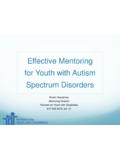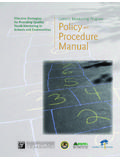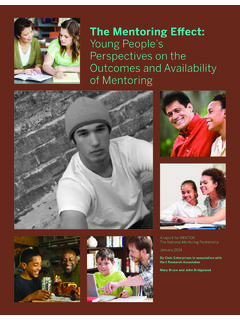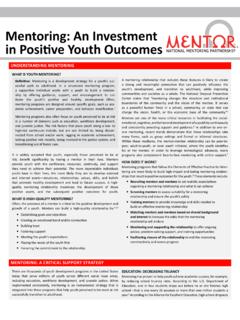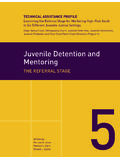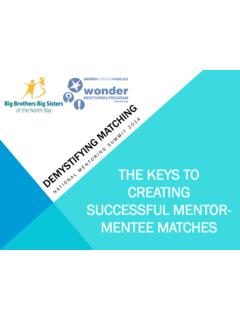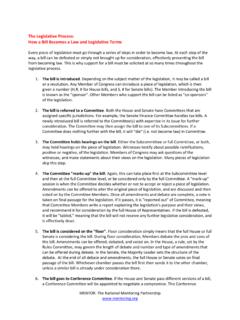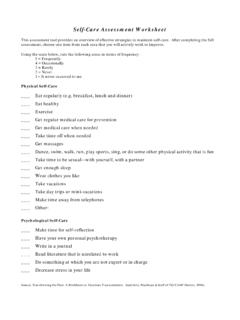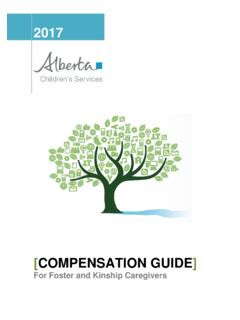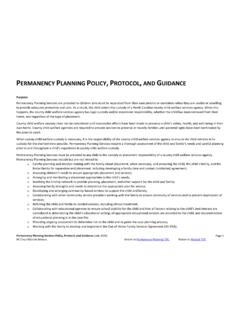Transcription of Mentor Tool Kit
1 How to Build A Successful Mentoring Program Using theElements of Effective PracticeTMA STEP-BY-STEP TOOL KIT FOR PROGRAM MANAGERSMENTOR/National Mentoring Partnership1600 Duke Street, Suite 300 Alexandria, VA 22314 Phone: 703-224-2200 Web site: Keyword: mentorOnline version of the tool kit: 2005. Mentor /National Mentoring PartnershipAll rights reserved. Published in the United States of rights: Permission to reproduce or photocopy portions of this tool kit with attribution is granted by Mentor /National Mentoring and resources submitted for inclusion in this tool kit have been edited or condensed from their original versionin order to accommodate the design and intent of this Mentor /National Mentoring Partnership1 Our State and Local Mentoring Partnerships1 Resources State and Local Mentoring Partnerships3 National Mentoring Institute5 Section II.
2 About the Tool Kit 7 Why Create a Tool Kit?7 Guidelines for New and Existing Programs7 What You ll Find in the Tool Kit8 Glossary of Terms9 Let s Get Started!10 Section III. Introduction to Mentoring and Program-Building11 What Is Mentoring Today?11 What Makes a Successful Mentoring Relationship?11 The Five Types of Mentoring 12 What Elements Constitute a Safe and Effective Mentoring Program?13 What s the Next Step?14 Section IV. How to Design and Plan a Mentoring Program15 Start with the Need15 Design the Parameters for Your Program15 Plan How the Program Will Be Managed21 Select the Management Team21 Establish Policies and Procedures22 Implement Ongoing Staff Training and Professional Development22 Develop a Financial Plan22 Implement the Program23 Plan How to Evaluate the Program23 Checklist of Program Progress: Program Design and Planning25 Additional Resources27 Tools Located on CDTab AiiiCONTENTSivHOW TO BUILD A SUCCESSFUL MENTORING PROGRAM USING THE ELEMENTS OF EFFECTIVE PRACTICET ools by Category Program Planning Program Parameters Program Planning and Management Policies and Procedures Financial Planning E-mentoringSection V.
3 How to Manage a Program for Success53 Form an Advisory Group53 Develop a Comprehensive System for Managing Program Information55 Design a Resource Development Plan That Allows for Diversified Fundraising57 Design a System to Monitor the Program58 Create a Professional Staff Development Plan59 Advocate for Mentoring 60 Establish a Public Relations/Communications Effort61 Partner and Collaborate with Other Organizations63 Checklist of Program Progress: Program Management65 Additional Resources69 Tools Located on CDTab BTools by Category Advisory Group Program Information Management Resource Development Professional Staff Development Advocacy Public Relations/Communications and Marketing CollaborationSection to Structure Effective Program Operations91 Build the Right Structure91 Recruit Mentors, Mentees and Other Volunteers91 Screen Potential Mentors and Mentees96 Orient and Train Mentors, Mentees and Parents/Caregivers100 Match Mentors and Mentees103 Bring Mentors and Mentees Together for Mentoring Sessions That Fallwithin the Program Parameters104 Provide Ongoing Support.
4 Supervision and Monitoring of Mentoring Relationships105 Recognize the Contributions of All Program Participants106 Help Mentors and Mentees Reach Closure107 CONTENTSC hecklist of Program Progress: Program Operations109 Additional Resources113 Tools Located on CDTab CTools by Category Recruitment Screening Orientation Training Matching Activities Ongoing Support and Supervision Mentor Recognition Structured Match ClosureSection to Establish Evaluation Criteria and Methods163 Measure Program Process163 Measure Expected Outcomes163 Create a Process to Reflect on and Disseminate Findings164 Gauging the Effectiveness of Youth Mentoring, by Dr. Jean Rhodes164 The Nuts and Bolts of Evaluating Mentoring Programs165 Checklist of Program Progress: Program Evaluation169 Additional Resources171 Tools Located on CDTab D Program EvaluationSection VIII.
5 Wrap-Up and Feedback181 Evaluation Form183 Endnotes 187vCONTENTSFOREWORDYou have in your hands How to Build a Successful Mentoring Program Using the Elements of Effective Practice, the latest and perhaps most important work in years to advance qualitymentoring. This comprehensive tool kit includes tools, templates and advice for implementingand adhering to the second edition of the Elements of Effective Practice rigorous guidelines that,when followed, will help to ensure quality tool kit was made possible by a generous grant from the Charles Stewart Mott Foundationand is the latest offering from Mentor /National Mentoring Partnership and the vital networkof State Mentoring Partnerships. For more than a decade, we have been leading the movement toconnect America s young people with caring adult mentors.
6 We serve as the Mentor s Mentor , providing a wide range of resources and technical assistance to more than 4,300 mentoringprograms across the 1990, we joined with United Way of America to convene a blue-ribbon panel of mentoringexperts to produce the nation s first set of rigorous mentoring guidelines, the first edition of theElements of Effective Practice. Those Elementsserved as the gold standard for quality mentoringfor more than a decade. Since then, the world of mentoring has changed. New types of mentoring have taken hold,requiring new guidelines. In 2003, through the generosity of the Charles Stewart MottFoundation, we again convened a blue-ribbon panel of mentoring experts to produce the second edition of the Elements of Effective Practice,which reflects the latest mentoring research,experience and practices.
7 Among the experts contributing to the effort were two of the nation stop mentoring researchers: Dr. Jean Rhodes of the University of Massachusetts, Boston, and Dr. David DuBois of the University of Illinois at Chicago. Whether you are new to mentoring or an old hand, this tool kit will save you time and effort,because it contains materials and information you need to start or maintain a quality mentoringprogram. The tool kit is written to follow the format of the Elements but it allows you to takeportions of the tool kit in a different order, depending on where you are in starting orstrengthening your mentoring hope you will use the tool kit with great success. For further assistance, we encourage you toreach out to your State Mentoring Partnershipor visit , to find the latest resourcesfor the mentoring field.
8 And, as always, we very much welcome your Partnership,Gail ManzaTonya WileyExecutive DirectorVice-PresidentviiFOREWORDACKNOWL EDGEMENTSMENTOR gratefully acknowledges the Charles Stewart Mott Foundation for its generous support for the tool kit. We thank An-Me Chung, program officer of the foundation, for herleadership and vision in the development of this resource for the mentoring gratefully acknowledge the guidance, feedback and unwavering support for the developmentof the tool kit provided by members of our Advisory Council:Advisory CouncilixACKNOWLEDGEMENTSJean Lahage CohenMentoring Partnership of Long IslandJoyce CorlettBig Brothers Big Sisters of AmericaDavid DuBois, Health SciencesSchool of Public Health University of Illinois at ChicagoSusan K.
9 PatrickThe Connecticut Mentoring PartnershipJean Rhodes, of Massachusetts, BostonRosemary TownsendBaylor University Health ServicesSusan Weinberger, Consulting GroupChair, Mentor Public Policy CouncilState and Local Mentoring PartnershipsWe would like to thank our network of State and Local Mentoring Partnershipsfor their supportof this tool kit. We extend our sincere appreciation to the following Mentoring Partnershipsthatshared resources and ideas: California Governor s Mentoring PartnershipThe Connecticut Mentoring PartnershipFlorida Mentoring Partnership, VolunteerFlorida FoundationIowa Mentoring PartnershipThe Maryland Mentoring PartnershipMass Mentoring PartnershipMemphis Mentoring PartnershipMentoring Partnership of Long IslandThe Los Angeles Mentoring PartnershipThe Mentor Center of Palm Beach CountyThe Mentoring Partnership of New YorkOregon MentorsTexas Governor s Mentoring InitiativeVirginia Mentoring PartnershipxHOW TO BUILD A SUCCESSFUL MENTORING PROGRAM USING THE ELEMENTS OF EFFECTIVE PRACTICELead StaffOther ContributorsApplied Research ConsultingBest Buddies InternationalBig Brothers Big Sisters of the Greater Twin CitiesBoys & Girls Clubs of AmericaCamp Fire Georgia CouncilDare Mighty ThingsFriends for YouthGirl Scouts of the USAH arvard Graduate School of of
10 Greater MinneapolisUniversity of Texas at San AntonioYouth Development Strategies, Zappie-FerradinoProject StaffColleen Appleby-CarrollKathy JohnsonJennifer RichterCindy SturtevantEditor s note: All tools and resources submitted for inclusion have been edited and customizedto accommodate the needs of the tool Mentoring PartnershipMENTOR/National Mentoring Partnership ( Mentor ),founded in 1990, is leading the movement to connectAmerica s young people with caring adult mentors,because all children deserve the opportunity to achievetheir potential. As a result of certain life circum-stances, million young Americans today are inspecial need of mentors. Of that number, millionalready are in mentoring relationships. The million young people constitute what we call thenation s mentoring gap.
